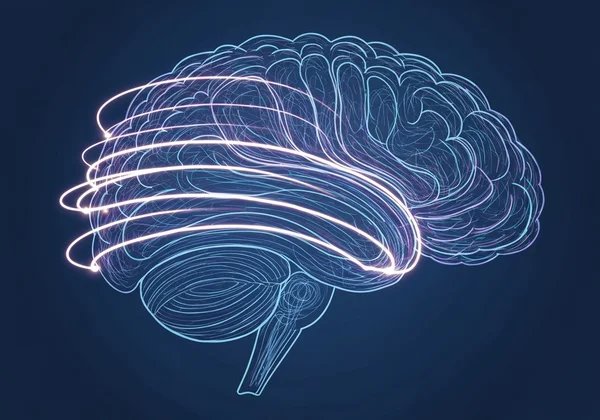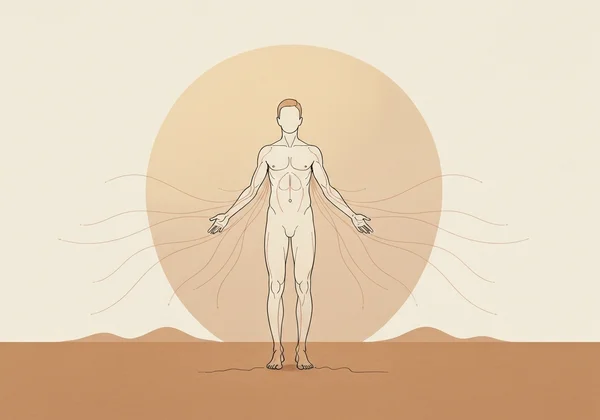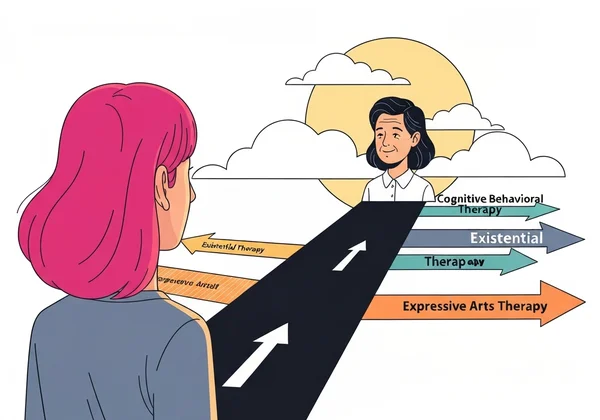Free Online Trauma Test: Finding Your Ideal Therapist (EMDR, Somatic Experiencing, CBT)
Navigating the path to healing after a difficult experience can feel overwhelming. You might be asking yourself, How do I know if I have trauma? This question is a courageous first step toward understanding. Recognizing that something isn't right is a sign of strength, and seeking support is the next powerful move. Finding the right trauma therapist is a deeply personal journey, but you don’t have to do it alone. This guide will illuminate three effective therapeutic approaches—EMDR, Somatic Experiencing, and Trauma-Informed CBT—to help you find the path that best fits your needs. Understanding your options is key to feeling empowered on your journey toward healing. If you're just beginning to explore your feelings, a great starting point is to gain some initial clarity with an online trauma screening.
EMDR Therapy Explained for Trauma Healing
Eye Movement Desensitization and Reprocessing (EMDR) is a structured therapy that has gained significant recognition for its effectiveness in treating trauma, particularly Post-Traumatic Stress Disorder (PTSD). It encourages the patient to briefly focus on the trauma memory while simultaneously experiencing bilateral stimulation (typically eye movements), which is associated with a reduction in the vividness and emotion of the memory.
What is EMDR and How Does It Work?
At its core, EMDR therapy helps the brain reprocess traumatic memories that have become "stuck." When a traumatic event occurs, the brain's information processing system can be overwhelmed, causing memories to be stored with the same distressing emotions, physical sensations, and thoughts that occurred during the event. EMDR uses bilateral stimulation—such as moving your eyes back and forth, alternating tones in your ears, or taps on your hands—to activate the brain's natural healing processes. This allows the memory to be "digested" and stored properly, reducing its emotional charge and allowing you to recall the event without feeling re-traumatized.
Who Benefits Most from EMDR Therapy?
While EMDR is highly effective for many, it is particularly well-suited for individuals struggling with single-incident traumas, such as a car accident, a natural disaster, or an assault. It is also a leading treatment for PTSD. If you experience intrusive memories, flashbacks, or nightmares related to a specific event, EMDR could be a powerful tool for your recovery. It can help you move from a state of being haunted by the past to one where the memory is simply a part of your story, not something that defines your present.

Somatic Experiencing: Releasing Trauma from the Body
Somatic Experiencing (SE) is a body-centered approach to healing trauma. It operates on the principle that trauma is not just an event that happened in the past but a physiological response trapped in the body. SE works to gently release this stored survival energy from the nervous system, helping individuals restore a sense of regulation and safety.
Understanding Somatic Experiencing Principles
Developed by Dr. Peter A. Levine, SE focuses on helping you develop a greater awareness of your bodily sensations. A therapist will guide you to notice how your body responds to stress and how it finds its way back to a calm state—a process called "pendulation." Instead of diving directly into the traumatic memory, the therapy moves slowly, "titrating" the experience in small, manageable doses. This gentle process helps the nervous system complete the self-protective motor responses (like fight or flight) that were frozen during the event, allowing the trapped energy to be released without overwhelming you. Understanding your body's reactions is a critical part of healing, and our free online trauma test can help you start.
Is Somatic Experiencing Right for Your Trauma Journey?
Somatic Experiencing is particularly beneficial for those who feel disconnected from their bodies, experience unexplained physical symptoms (like chronic pain or digestive issues), or struggle with feelings of being frozen or numb. If you find that talking about your trauma is too overwhelming or doesn't seem to help, a body-based approach like SE might be the key. It offers a path to healing that honors the body's wisdom and innate capacity to heal itself, making it a powerful option for addressing complex and childhood trauma.

Trauma-Informed CBT: A Cognitive Approach to Healing
Cognitive Behavioral Therapy (CBT) is a well-known therapeutic approach that focuses on changing unhelpful patterns of thinking and behavior. Trauma-Informed CBT applies these principles with a deep understanding of trauma's pervasive impact, prioritizing the survivor's safety, trust, and sense of control throughout the therapeutic process.
Key Principles of Trauma-Focused Cognitive Behavioral Therapy
Trauma-Focused CBT (TF-CBT) helps individuals understand the connections between their thoughts, feelings, and behaviors as they relate to their traumatic experiences. A therapist works with you to identify distorted or negative thoughts—such as self-blame or a belief that the world is entirely unsafe—and helps you challenge and reframe them into more balanced and realistic perspectives. The therapy also involves gradually exposing you to trauma reminders in a safe, controlled way to reduce fear and anxiety, a technique known as exposure therapy. It is a structured, skills-based approach aimed at empowering you with practical coping tools.
Who Can Benefit from Trauma-Informed CBT?
This approach is highly effective for individuals who are struggling with specific trauma-related anxieties, phobias, and negative belief systems. If you find yourself stuck in cycles of guilt, shame, or fear, or if you actively avoid situations that remind you of your trauma, TF-CBT can provide you with a clear roadmap for change. It is also a well-researched and effective treatment for children and adolescents who have experienced trauma. Gaining insight into your symptoms through a childhood trauma test can be a helpful precursor to starting therapy.
How to Find the Right Trauma Therapist for You
Choosing a therapist is one of the most important decisions on your healing journey. The right connection can create a safe space for growth and recovery. Here are some steps to guide you.

Essential Questions to Ask Potential Therapists
When you contact a potential therapist, don't be afraid to ask questions. This is your opportunity to see if they are a good fit. Consider asking:
- Are you a licensed mental health professional?
- What is your experience working with trauma survivors?
- Are you trained in specific trauma modalities like EMDR, Somatic Experiencing, or TF-CBT?
- What is your approach to creating safety in a therapy session?
- How do you view the healing process for trauma?
Resources for Finding Qualified Trauma Professionals
Finding a qualified professional often starts with a search. Look for online directories from professional organizations like the EMDR International Association (EMDRIA) or the Somatic Experiencing Trauma Institute. You can also ask for a referral from a trusted primary care physician. Look for terms like "trauma-informed," "trauma-specialist," or certifications in the specific therapies mentioned above. Taking a PTSD test first can provide you with a report to share with a potential therapist.
Considering Costs and Accessibility: Online vs. In-Person Therapy
Therapy is an investment in your well-being. Check if a therapist accepts your insurance or offers a sliding scale fee based on income. Today, online therapy has become a highly accessible and effective option, offering flexibility and convenience. In-person therapy provides a different kind of connection. Consider which format feels most comfortable and sustainable for you.
Empowering Your Healing Journey
Choosing a therapy and a therapist is a profound act of self-care. Whether you are drawn to the brain-based approach of EMDR, the body-focused work of Somatic Experiencing, or the cognitive skills of Trauma-Informed CBT, know that healing is possible. Each path offers a unique way to reclaim your life from the shadows of the past. Your journey starts with understanding, and a crucial first step can be recognizing the potential impact of your experiences. If you're ready to gain more insight, start your free trauma assessment on our homepage. You deserve to feel safe, whole, and hopeful about your future.

Frequently Asked Questions About Trauma Therapy & Healing
How do I know if I have trauma?
Trauma responses can look different for everyone. They can include persistent anxiety, flashbacks, nightmares, emotional numbness, difficulty in relationships, or feeling constantly on edge. A helpful first step is to explore these symptoms in a safe, confidential space. An online assessment like the free trauma test can provide initial insights into whether your experiences might be trauma-related.
Can you self-diagnose trauma?
While you are the expert on your own life and feelings, a formal diagnosis can only be made by a licensed mental health professional. Self-assessment tools can be incredibly validating and are designed to be an educational first step, not a substitute for professional evaluation. They can help you organize your thoughts and feelings before speaking with a professional.
What is the most accurate trauma test?
The accuracy of a test depends on its design and purpose. Clinically administered assessments are used for diagnosis. High-quality online screening tools, like our free trauma assessment, are scientifically designed to be reliable preliminary indicators. They help identify potential symptoms and guide you toward seeking appropriate professional support.
How to heal from childhood trauma?
Healing from childhood trauma is a gradual process of building safety, processing memories, and reconnecting with yourself and others. Therapies like Somatic Experiencing and Trauma-Informed CBT are highly effective. The journey often involves learning to regulate your nervous system, challenging core beliefs formed in childhood, and grieving past losses. Our childhood trauma assessment can help you understand its potential impact.
What should I expect in my first trauma therapy session?
Your first session is primarily about building a connection and establishing safety. Your therapist will likely ask about what brought you to therapy, your history, and your goals. It is not a time to dive deep into traumatic details. The focus is on getting to know you and creating a safe, trusting relationship where healing can begin.